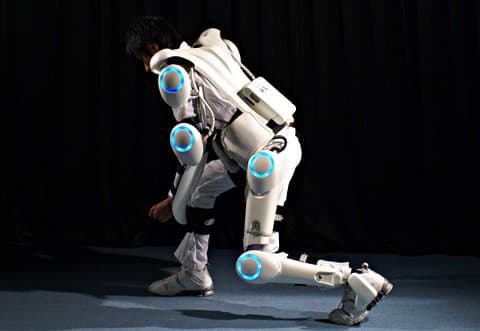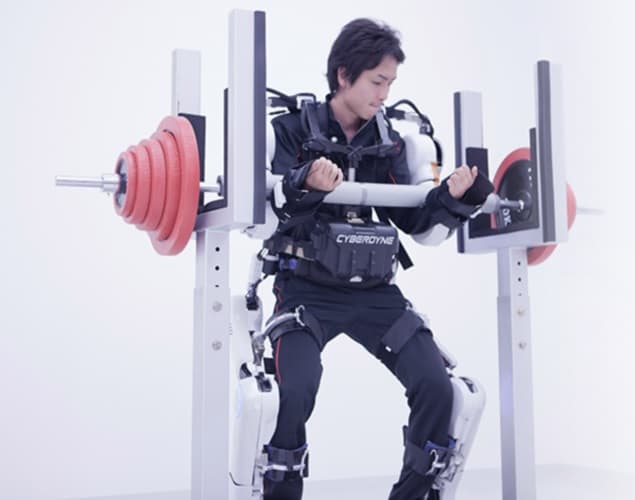Cyberdyne's Hybrid Assistive Limb Is A Thought-Controlled Robot
The folks from the Land of Rising Sun have always been at the forefront in the field of robotics and once again, they have given us a reason for confirming to that. Cyberdyne, a robot manufacturing company has developed a thought operated cyborg-type robot named HAL. HAL stands for "Hybrid Assistive Limb", which as the name suggests, assists the wearer in making physical movements. The HAL is actually a cyborg-suit which may find a wide range of applications from search and rescue to helping the elderly and disabled to get around.

As mentioned earlier, HAL will sense your thoughts and will assist your muscles in making movements with a greater force. HAL works in a way identical to a human body. First, the brain thinks about a certain motion and then sends a corresponding electrical signal to that part. The speed of signals that are conveyed from the brain to each muscle is between approximately 150 km/h and 400 km/h. In order to actualize complex bodily motions for walking, the brain always controls number of muscles based on various information from the whole body. Now this is where HAL comes into picture.

The signals sent from the brain leak on the skin as extremely faint signals (called bio-electric signals) whose voltages are only from 1/1000th to 1/100,000th of the ones that are exerted by dry batteries. HAL reads these signals by the detectors on the wearer's skin. Utilizing that information, HAL recognizes what sorts of motions the wearer intends. The wearers limb now makes the motion but with much power than than it could exert on its own. In the case of handicapped people, their brain will learn from the motions and eventually it will emit necessary signals for 'walking' gradually. Thus physically challenged persons can be taught to walk by HAL and then they would be able to do so without being assisted by HAL.
Applications of HAL include reinforcing whole bodily functions from the upper limbs to the lower limbs, making impossible heavy works for human power possible. Also, HAL can be for Disaster Recovery, in order to assist human activity for disaster recovery under extraordinary environments. Of course, the suit will have to be enclosed in a a radiation shielding jacket, a wearer cooling system and a vital sensing system. Cyberdyne claims that the suit is weather and terrain proof and can be put on or taken off in a minute.
Source: <a href="https://www.cyberdyne.jp/english/products/HAL/index.html" target="_blank" rel="nofollow noopener noreferrer">The world's first Wearable Cyborg "HAL" - CYBERDYNE</a>

As mentioned earlier, HAL will sense your thoughts and will assist your muscles in making movements with a greater force. HAL works in a way identical to a human body. First, the brain thinks about a certain motion and then sends a corresponding electrical signal to that part. The speed of signals that are conveyed from the brain to each muscle is between approximately 150 km/h and 400 km/h. In order to actualize complex bodily motions for walking, the brain always controls number of muscles based on various information from the whole body. Now this is where HAL comes into picture.

The signals sent from the brain leak on the skin as extremely faint signals (called bio-electric signals) whose voltages are only from 1/1000th to 1/100,000th of the ones that are exerted by dry batteries. HAL reads these signals by the detectors on the wearer's skin. Utilizing that information, HAL recognizes what sorts of motions the wearer intends. The wearers limb now makes the motion but with much power than than it could exert on its own. In the case of handicapped people, their brain will learn from the motions and eventually it will emit necessary signals for 'walking' gradually. Thus physically challenged persons can be taught to walk by HAL and then they would be able to do so without being assisted by HAL.
Applications of HAL include reinforcing whole bodily functions from the upper limbs to the lower limbs, making impossible heavy works for human power possible. Also, HAL can be for Disaster Recovery, in order to assist human activity for disaster recovery under extraordinary environments. Of course, the suit will have to be enclosed in a a radiation shielding jacket, a wearer cooling system and a vital sensing system. Cyberdyne claims that the suit is weather and terrain proof and can be put on or taken off in a minute.
This futuristic suit will be a cornerstone in the development of human controlled power-assisted robotic suits. Although Cyberdyne has made this one perfect, I think they might have missed the jetpack in the back. What do you think about the suit? Would you like to add any more features to this? Share with us in the comments.Source: <a href="https://www.cyberdyne.jp/english/products/HAL/index.html" target="_blank" rel="nofollow noopener noreferrer">The world's first Wearable Cyborg "HAL" - CYBERDYNE</a>
0
